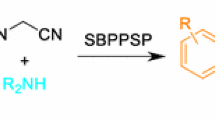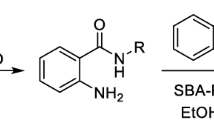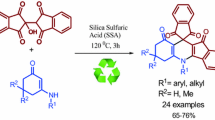Abstract
Silica-bonded N-propyltriethylenetetramine was used as a heterogeneous solid base catalyst for the synthesis of spirooxindole pyrimidines by a one-pot condensation reaction of isatin, activated methylene reagent, and barbituric acid or thiobarbituric acid in aqueous medium in good to high yields. Catalyst could be recycled for several times without any additional treatment.
Graphical Abstract

Similar content being viewed by others
Avoid common mistakes on your manuscript.
Introduction
Spirooxindoles are commonly occurring heterocyclic ring systems and are important structural motifs found in many natural products and pharmaceuticals [1–5] (Fig. 1). For example, spirotryprostatins A and B (1 and 2) were isolated from the fermentation broth of Aspergillus fumigatus and have been shown to completely inhibit the G2/M progression of mammalian tsFT210 cells at concentrations in excess of 12.5 mg cm−3 [6, 7]. Pteropodine (3) has been shown to modulate the function of muscarinic serotonin receptors [8]. (−)-Horsfiline (4a) was isolated in 1991 [9] is one of the relatively unsubstituted spirooxindole cores. The related compound coerulescine (4b), which possesses an even simpler structure, was isolated in 1998; its synthesis is often reported together with that of horsfiline [10]. Further, strychnofoline (5) has been found to inhibit mitosis in a number of cell lines including mouse melanoma B16, Ehrlich, and Hepatom HW165 [11]. Alstonisine (6), a natural alkaloid, was first isolated from Alstonia muelleriana [12–14] and has been identified for its biomimetic transformations [15]. Chitosenine (7) is another structurally interesting natural product that exhibits short-lived inhibitory activity of ganglionic transmission “in vivo” in rats and rabbits [16–18].
In recent years, numerous efficient transformations have been developed for the construction of spirooxindole structures [19–42]. In 1998, Edmonson and Danishefsky reported the first total synthesis of spirotryprostatin A; a stereoselective bromohydrin formation was used for the oxidative rearrangement to form the spirooxindole [19, 20]. Also, the synthesis of the precursor to the oxidative rearrangement was made in a simple three-step sequence in 1997 by Ganesan and co-workers [21]. Horne and co-workers [23, 24] synthesized a number of spirooxindole natural products using a novel N-acyliminium cyclization of 2-halotryptamine derivatives. Fuji et al. [27, 28] developed an asymmetric nitroolefination protocol using a chiral auxiliary that was applied to the synthesis of chiral oxindoles. Overman and co-workers [29–32] used an aza-Cope-Mannich rearrangement to put together the pyrrolidine ring in order, the synthesis of asymmetric synthesis of strychnine. Carreira and co-workers [36–38] have developed a reliable methodology to access the pyrrolidinyl-spirooxindole structure starting from imines and spirocyclopropyl oxindoles. Williams accessed both enantiomers of the target molecule and prepared analogs of the natural products in the synthesis of spirotryprostatin B [39–41]. Gong and co-workers [42] described an enantioselective organocatalytic approach for the rapid synthesis of spiro[pyrrolidin-3,3′-oxindole] derivatives in the presence of a chiral phosphoric acid.
Among them, the one-pot condensation reaction of isatin and activated methylene reagent could readily afford various spirooxindole pyramidine structures and has attracted wide attention, and this type of reaction has been achieved by a number of different catalysts and conditions, such as InCl3 [43], electrochemical methods [44], triethylbenzylammonium chloride (TEBA) [45], Et3N [46], tetrabutylammonium fluoride (TBAF) [47], NH4Cl [48], lipase [4], p-TSA [49], ZnS nanoparticles [50], NaCl under sonication [51], butylmethylimidazolium tetrafluoroborate ([BMIm]BF4) [52], amino-functionalized SBA-15 [53], CaCl2 under ultrasonic irradiation [54], piperidine under ultrasonic irradiation [55], nanocrystalline MgO [56], gluconic acid [57], MnFe2O4 nanoparticles [58], 1,8-diazabicyclo[5.4.0]undec-7-ene (DBU) [59], ethylenediammonium diformate (EDDF) [60], and sulfated choline based heteropolyanion [61] which some of them suffer from technical intricacy and generation of mixtures of pyrans and unsaturated nitriles.
The potential use of microporous and mesoporous base catalysts in fine chemical production is enormous [62, 63]. These heterogeneous catalysts are known to suppress side reactions, which include self-condensation and oligomerization, resulting in better selectivity and product yield. Also, heterogeneous catalysts are advantageous over conventional homogeneous catalysts as they can be easily recovered from the reaction mixture by simple filtration and can be reused after activation, thereby making the process economically viable. Recently, we prepared silica-bonded N-propyltriethylenetetramine (SBNPTT) as solid base catalyst (Fig. 2) and its catalytic activity was investigated for the synthesis of 4,4′-(arylmethylene)bis(1H-pyrazol-5-ols) [63] and chromenes [64].
Along the line of our studies in application of heterogeneous catalysts in chemical transformations [63–73] herein, we wish to describe the application of SBNPTT as a solid base catalyst for the synthesis of spirooxindole derivatives.
Results and discussion
In our initial study, evaluation of a series of silica immobilized bases (SBNPTT, SBPP, SBPM, and 3-SPA) was carried out for the synthesis of spirooxindole pyrimidines in aqueous medium. After some preliminary experiments, it was found that a mixture of isatin, malononitrile, and barbituric acid in refluxing water in the presence of a catalytic amount of these heterogeneous solid bases could afford 7′-amino-2,2′,4′-trioxo-1′,2′,3′,4′-tetrahydrospiro[indoline-3,5′-pyrano[2,3-d]pyrimidine]-6′-carbonitrile one (4a) in excellent yield (Table 1).

We examined this reaction in the absence of catalyst and it was found that when the reaction was carried out without any catalyst resulted in poor yield (Table 1, entry 1). The best result was obtained when SBNPTT was used for which the yield was up to 95 % (Table 1, entry 3). In addition, the result of this condensation in the presence of other silica immobilized bases (3-SPA, SBPP, and SBPM) gave corresponding product in slightly longer reaction time and lower yield (Table 1, entries 5–7). The condensation reaction under solvent-free conditions at 120 °C gave corresponding product in 80 % yield after 120 min (Table 1, entry 8). So, the optimal amount of SBNPTT was 0.03 g (2.77 mol% [63]) per 1 mmol of isatin in refluxing water.
Therefore, we employed the optimized conditions (0.03 g mmol−1 of SBNPTT in refluxing water) for the condensation reaction of isatin, malononitrile with 1,3-dicarbonyl compounds [barbituric acid (3a), thiobarbituric acid (3b), dimedine (3c), and 1,3-cyclohexadione (3d)] into the corresponding spirooxindole derivatives (Scheme 1).

As shown in Table 2, it was found that this method works with a wide variety of substrates. A series of different position substituted isatins including either electron-withdrawing or halogen groups reacted with malononitrile and barbituric acid under optimized conditions and corresponding products were obtained in high yields. Also, thiobarbituric acid was treated with isatins and malononitrile gave corresponding products in good to high yields (Table 2, entries 6–8). In addition, dimedone and 1,3-cyclohexanedione were used in this three-component condensation reaction (Table 2, entries 9–16). Dimedone reacted with isatines and malononitrile or ethyl cyanoacetate under optimized conditions and corresponding products were obtained in high yields (Table 2, entries 9–14). The reaction with ethyl cyanoacetate or malononitrile also proceeded smoothly; however, the reaction time of ethyl cyanoacetate with isatins and 1,3-dicarbonyl compounds was longer than those of malononitrile, which is probably due to the lower reactivities of the cyanoacetates.
Proposed mechanism for the synthesis of spiro derivative 4 was described in Scheme 2 [45, 64, 72]. The process represents a typical cascade reaction in which the isatin 1 first condenses with malononitrile (2a) to afford isatylidene malononitrile derivative 5 in the presence of SBNPTT in water. This step was regarded as a fast Knoevenagel condensation. Then, 5 is attacked via Michael addition of 1,3-dicarbonyl compound 3 to give the intermediate 6 followed by the cycloaddition of hydroxyl group to the cyano moiety to form the desired product 4 (Scheme 2).

The possibility of recycling the catalyst SBNPTT was examined using the reaction of isatin, malononitrile, and barbituric acid under the optimized conditions. Upon completion, the reaction mixture was washed with warm ethanol (3 × 5 cm3). The recovered catalyst was washed with diethyl ether, dried, and reused for subsequent runs. The recycled catalyst was reused four times without any additional treatment. No observation of any appreciable loss in the catalytic activity of SBNPTT was observed (Fig. 3).
In conclusion, we have prepared some new spirooxindole derivatives by three-component condensation reaction of isatin, reactive methylene reagents, with 1,3-dicarbonyl compounds in the presence of SBNPTT as a solid base catalyst in refluxing water.
Experimental
Chemicals were purchased from Fluka, Merck, and Aldrich chemical companies. Known compounds were characterized by comparison of their IR, 1H NMR, and 13C NMR spectroscopic data and their melting points with reported values [4, 5, 44–55].
General procedure for the synthesis of spirooxindoles
A mixture of isatin (1 mmol), reactive methylene compound (1 mmol), and 1,3-dicarbonyl compound (1 mmol) in the presence of 0.03 g SBNPTT (2.77 mol%) in 3 cm3 water was refluxed with stirring in an oil bath. The progress of the reaction was monitored by TLC. After completion of the reaction, the mixture was filtered and remaining was washed with warm ethanol (3 × 5 cm3) to separate SBNPTT catalyst. After cooling the ethanol phase the precipitates were filtered. The crude products were purified by recrystallization from ethanol (95 %). The recovered catalyst was washed with diethyl ether, dried, and reused for subsequent runs.
7′-Amino-5-bromo-2,2′,4′-trioxo-1′,2′,3′,4′-tetrahydrospiro[indoline-3,5′-pyrano[2,3-d]pyrimidine]-6′-carbonitrile (4b, C15H8BrN5O4)
White solid; m.p.: 258–260 °C; IR (KBr): \( \bar{v} \) = 3,450, 3,291, 3,160, 2,197, 1,693, 1,535 cm−1; 1H NMR (400 MHz, DMSO-d 6 ): δ = 6.70–6.87 (m, 1H), 7.23–7.80 (m, 4H), 10.57 (s, 1H, NH), 11.11 (s, 1H, NH), 12.28 (brs, 1H, NH) ppm; 13C NMR (100 MHz, DMSO-d 6 ): δ = 48.5, 58.7, 87.9, 112.8, 115.1, 118.5, 128.4, 132.7, 137.6, 143.0, 150.9, 155.2, 160.0, 163.1, 178.7 ppm.
7′-Amino-5-chloro-2,2′,4′-trioxo-1′,2′,3′,4′-tetrahydrospiro[indoline-3,5′-pyrano[2,3-d]pyrimidine]-6′-carbonitrile (4c, C15H8ClN5O4)
White solid; m.p.: 237–240 °C; IR (KBr): \( \bar{v} \) = 3,452, 3,292, 3,160, 2,196, 1,694, 1,535, 1,477, 1,335 cm−1; 1H NMR (400 MHz, DMSO-d 6 ): δ = 6.80 (d, 1H, J = 8.1 Hz), 7.21 (dd, 1H, J 1 = 4.3 Hz, J 2 = 2.2 Hz), 7.34 (d, 1H, J = 2.2 Hz), 7.45 (s, 2H, NH2), 10.61 (s, 1H, NH), 11.16 (s, 1H, NH), 12.33 (brs, 1H, NH) ppm; 13C NMR (100 MHz, DMSO-d 6 ): δ = 46.9, 57.0, 86.2, 110.6, 116.8, 124.1, 125.8, 128.2, 135.6, 141.0, 153.5, 158.3, 161.5, 177.5 ppm.
7′-Amino-5-nitro-2,2′,4′-trioxo-1′,2′,3′,4′-tetrahydrospiro[indoline-3,5′-pyrano[2,3-d]pyrimidine]-6′-carbonitrile (4d, C15H8N6O6)
White solid; m.p.: 286–288 °C; IR (KBr): \( \bar{v} \) = 3,442, 3,296, 3,173, 2,199, 1,748, 1,687, 1,632, 1,521, 1,477, 1,345, 1,253, 1,230 cm−1; 1H NMR (400 MHz, DMSO-d 6 ): δ = 6.80–7.30 (m, 1H), 7.53 (s, 2H, NH2), 8.07–8.40 (m, 2H), 11.15–11.30 (m, 2H, 2 × NH), 12.38 (brs, 1H, NH) ppm; 13C NMR (100 MHz, DMSO-d 6 ): δ = 48.5, 57.7, 87.4, 111.0, 118.4, 121.6, 127.5, 136.2, 144.2, 150.2, 150.9, 155.5, 160.3, 163.3, 180.0 ppm.
7′-Amino-1′-methyl-2,2′,4′-trioxo-1′,2′,3′,4′-tetrahydrospiro[indoline-3,5′-pyrano[2,3-d]pyrimidine]-6′-carbonitrile (4e, C16H11N5O4)
White solid; m.p.: 240–242 °C; IR (KBr): \( \bar{v} \) = 3,467, 3,383, 3,164, 2,206, 1,705, 1,610, 1,526, 1,470, 1,324, 1,244, 1,113 cm−1; 1H NMR (400 MHz, DMSO-d 6 ): δ = 3.19 (s, 3H), 7.04–7.07 (m, 2H), 7.26 (d, 1H, J = 6.3 Hz), 7.33 (dt, 1H, J 1 = 6.1 Hz, J 2 = 1.0 Hz), 7.48 (s, 2H, NH2), 11.17 (s, 1H, NH), 12.39 (brs, 1H, NH) ppm; 13C NMR (125 MHz, DMSO-d 6 ): δ = 26.9, 46.8, 57.8, 87.2, 108.7, 117.3, 123.0, 124.0, 129.1, 133.2, 144.1, 149.7, 153.8, 158.8, 161.8, 176.6 ppm.
7′-Amino-5-bromo-2,4′-dioxo-2′-thioxo-1′,2′,3′,4′-tetrahydrospiro [indoline-3,5′-pyrano[2,3-d]pyrimidine]-6′-carbonitrile (4g, C15H8BrN5O3S)
White solid; m.p.: 249–251 °C; IR (KBr): \( \bar{v} \) = 3,426, 3,311, 3,160, 2,200, 1,693, 1,655, 1,615, 1,570, 1,460 cm−1; 1H NMR (400 MHz, DMSO-d 6 ): δ = 6.77 (s, 1H), 7.31–7.75 (m, 4H), 10.69 (s, 1H, NH), 12.54 (s, 1H, NH), 13.81 (brs, 1H, NH) ppm; 13C NMR (100 MHz, DMSO-d 6 ): δ = 46.8, 56.0, 90.9, 111.1, 113.6, 116.8, 127.0, 131.2, 135.4, 141.5, 152.9, 158.1, 159.2, 173.9, 177.0 ppm.
7′-Amino-5-fluoro-2,4′-dioxo-2′-thioxo-1′,2′,3′,4′-tetrahydrospiro [indoline-3,5′-pyrano[2,3-d]pyrimidine]-6′-carbonitrile (4h, C15H8FN5O3S)
White solid; m.p.: 252–255 °C; IR (KBr): \( \bar{v} \) = 3,425, 3,313, 3,161, 2,201, 1,694, 1,656, 1,615, 1,570, 1,469 cm−1; 1H NMR (400 MHz, DMSO-d 6 ): δ = 6.76–6.79 (m, 1H), 6.97–7.02 (m, 1H), 7.23 (dd, 1H, J 1 = 8.2 Hz, J 2 = 2.6 Hz), 7.48 (s, 2H, NH2), 10.56 (s, 1H, NH), 12.50 (s, 1H, NH), 13.84 (brs, 1H, NH) ppm; 13C NMR (125 MHz, DMSO-d 6 ): δ = 47.6, 57.4, 91.6, 110.4, 110.4, 112.4, 112.6, 115.2, 115.4, 117.2, 135.1, 135.2, 138.8, 153.4, 159.1 (J C–F = 128.2 Hz), 174.5, 177.8 ppm.
References
Cheng D, Ishihara Y, Tan B, Barbas CF (2014) ACS Catal 4:743
Ding K, Lu YP, Coleska N (2006) J Med Chem 49:3432
Galliford CV, Scheidt KA (2007) Angew Chem Int Ed 46:8748
Chai SJ, Lai YF, Xu JC, Zheng H, Zhu Q, Zhang PF (2011) Adv Synth Catal 353:371
Galliford CV, Martenson JA, Stern C, Scheidt KA (2007) Chem Commun 631
Cui CB, Kakeya H, Osada H (1996) Tetrahedron 52:12651
Cui CB, Kakeya H, Osada H (1996) J Antibiot 49:832
Kang TH, Matsumoto K, Murakami Y, Takayama H, Kitajima M, Aimi N, Watanabe H (2002) Eur J Pharmacol 444:39
Jossang A, Jossang P, Hadi HA, Sevenet T, Bodo B (1991) J Org Chem 56:6527
Anderton N, Cockrum PA, Colegate SM, Edgar JA, Flower K, Vit I, Willing RI (1998) Phytochemistry 48:437
Dideberg O, Lamotte-Brasseur J, Dupont L, Campsteyn H, Vermeire M, Angenot L (1977) Acta Crystallogr Sect B 33:1796
Elderfield RC, Gilman RE (1972) Phytochemistry 11:339
Ghedira K, Zeches-Hanrot M, Richard B, Massiot G, Le Men-Oliver L, Sevener T, Goh SH (1988) Phytochemistry 27:3955
Wong WH, Lim PB, Chuah CH (1996) Phytochemistry 41:313
Garnick RL, Le Quesne PW (1978) J Am Chem Soc 100:4213
Sakai S, Aimi N, Yamaguchi K, Ohhira H, Hori K, Haginiwa J (1975) Tetrahedron Lett 16:715
Aimi N, Yamaguchi K, Sakai S, Haginiwa J, Kubo A (1978) Chem Pharm Bull 26:3444
Sakai S, Aimi N, Yamaguchi K, Yamanaka E, Haginiwa J (1982) J Chem Soc Perkin Trans 1:1257
Edmondson S, Danishefsky SJ, Sepp-Lorenzino L, Rosen N (1999) J Am Chem Soc 121:2147
Edmonson SD, Danishefsky SJ (1998) Angew Chem Int Ed 37:1138
Wang HS, Ganesan A (1997) Tetrahedron Lett 38:4327
Wang HS, Ganesan A (2000) J Org Chem 65:4685
Miyake FY, Yakushijin K, Horne DA (2004) Org Lett 6:711
Miyake FY, Yakushijin K, Horne DA (2004) Angew Chem Int Ed 43:5357
Baran PS, Richter JM (2005) J Am Chem Soc 127:15394
Baran PS, Maimone TJ, Richter JM (2007) Nature 446:404
Fuji K, Kawabata T, Ohmori T, Node M (1995) Synlett 367
Fuji K, Node M, Nagasawa H, Naniwa Y, Taga T, Machida K, Snatzke G (1989) J Am Chem Soc 111:7921
Overman LE, Peterson EA (2003) Tetrahedron 59:6905
Matsuura T, Overman LE, Poon DJ (1998) J Am Chem Soc 120:6500
Huang A, Kodanko JJ, Overman LE (2004) J Am Chem Soc 126:14043
Overman LE, Rosen MD (2000) Angew Chem Int Ed 39:4596
Trost BM, Stambuli JP, Silverman SM, Schworer U (2006) J Am Chem Soc 128:13328
Trost BM, Cramer N, Silverman SM (2007) J Am Chem Soc 129:12396
Trost BM, Brennan MK (2009) Synthesis 3003
Meyers C, Carreira EM (2003) Angew Chem 115:718
Marti C, Carreira EM (2005) J Am Chem Soc 127:11505
Wuitschik G, Rogers-Evans M, Buckl A, Bernasconi M, Marki M, Godel T, Fischer H, Wagner B, Parrilla I, Schuler F, Schneider J, Alker A, Schweizer WB, Muller K, Carreira EM (2008) Angew Chem Int Ed 47:4512
Sebahar PR, Williams RM (2000) J Am Chem Soc 122:5666
Onishi T, Sebahar PR, Williams RM (2003) Org Lett 5:3135
Williams RM, Cao J, Tsujishima H, Cox RJ (2003) J Am Chem Soc 125:12172
Chen XH, Wei Q, Luo SW, Xiao H, Gong LZ (2009) J Am Chem Soc 131:13819
Shanthi G, Subbulakshmi G, Perumal PT (2007) Tetrahedron 63:2057
Elinson MN, Ilovaisky AI, Dorofeev AS, Merkulova VM, Stepanov NO, Miloserdov FM, Ogibin YN, Nikishin GI (2007) Tetrahedron 63:10543
Zhu SL, Ji SJ, Zhang Y (2007) Tetrahedron 63:9365
Litvinov YM, Mortikov VY, Shestopalov AM (2008) J Comb Chem 10:741
Gao S, Tsai CH, Tseng C, Yao CF (2008) Tetrahedron 64:9143
Dabiri M, Bahramnejad M, Baghbanzadeh M (2009) Tetrahedron 65:9443
Jadidi K, Ghahremanzadeh R, Bazgir A (2009) J Comb Chem 11:341
Dandia A, Parewa V, Jain AK, Rathore KS (2011) Green Chem 13:2135
Dandia A, Jain AK, Bhati DS (2011) Synth Commun 41:2905
Rad-Moghadam K, Youseftabar-Miri L (2011) Tetrahedron 67:5693
Ziarani GM, Badiei A, Mousavi S, Lashgari N, Shahbazi A (2012) Chin J Catal 33:1832
Safaei HR, Shekouhy M, Shirinfeshan A, Rahmanpur S (2012) Mol Divers 16:669
Zou Y, Hu Y, Liu H, Shi D (2012) ACS Comb Sci 14:38
Karmakar B, Nayak A, Banerji J (2012) Tetrahedron Lett 53:5004
Guo RY, Wang P, Wang GD, Mo LP, Zhang ZH (2013) Tetrahedron 69:2056
Ghahremanzadeh R, Rashid Z, Zarnani AH, Naeimi H (2013) Appl Catal A Gen 467:270
Saluja P, Aggarwal K, Khurana JM (2013) Synth Commun 43:3239
Thakur A, Tripathi M, Rajesh UC, Rawat DS (2013) RSC Adv 3:18142
Satasia SP, Kalaria PN, Avalani JR, Raval DK (2014) Tetrahedron 70:5763
Weitkamp J, Hunger M, Rymsa U (2001) Microporous Mesoporous Mater 48:255
Niknam K, Sadeghi Habibabad M, Deris A, Aeinjamshid N (2013) Monatsh Chem 144:987
Makvandi M, Abiar Dil F, Malekzadeh A, Baghernejad M, Niknam K (2013) Iran J Catal 3:221
Tayebi S, Baghernejad M, Saberi D, Niknam K (2011) Chin J Catal 32:1477
Niknam K, Deris A, Naeimi F, Majleci F (2011) Tetrahedron Lett 52:4642
Nouri Sefat M, Deris A, Niknam K (2011) Chin J Chem 29:2361
Baghernejad M, Niknam K (2012) Int J Chem 4:52
Niknam K, Jamali A, Tajaddod M, Deris A (2012) Chin J Catal 33:1312
Pargaleh Brojeni S, Baghernejad M, Saberi D, Niknam K (2013) Green Chem Lett Rev 6:69
Niknam K, Jamali A (2012) Chin J Catal 33:1840
Niknam K, Borazjani N, Rashidian R, Jamali A (2013) Chin J Catal 34:2245
Niknam K, Rashidian R, Jamali A (2013) Scientia Iran C 20:1863
Acknowledgments
We are thankful to the Persian Gulf University Research Council for the partial support of this work. Also, we are thankful to the School of Chemistry, Manchester University for running NMRs.
Author information
Authors and Affiliations
Corresponding author
Electronic supplementary material
Below is the link to the electronic supplementary material.
Rights and permissions
About this article
Cite this article
Niknam, K., Abolpour, P. Synthesis of spirooxindole pyrimidines catalyzed by silica-bonded N-propyltriethylenetetramine as a recyclable solid base catalyst in aqueous medium. Monatsh Chem 146, 683–690 (2015). https://doi.org/10.1007/s00706-014-1343-1
Received:
Accepted:
Published:
Issue Date:
DOI: https://doi.org/10.1007/s00706-014-1343-1







